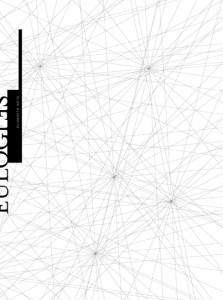
Eulogies, by Lyz Soto, was recently published by Tinfish Press. Not only is the poetry beautifully & powerfully written, but the book itself (like all Tinfish books) is strikingly designed. Lyz was kind enough to answer a few questions about her poetry & process. If you are interested, you can purchase the book here.
1) When did you begin writing Eulogies? Can you tell us a little bit
about the relationship captured in the book?
I started writing Eulogies while taking a poetry workshop with Susan Schultz at the University of Hawai`i, Manoa. It began as a response to reading Adrienne Rich's Atlas to a Difficult World, and grew into my response to a personal relationship that had its own difficult landscape. Eulogies revolves around my son's father, his battle with schizophrenia, and my experience of that battle.
Can you talk about your use of fragments? Especially in relation to
Sappho?
I was trying to capture the fragmented nature of profound mental illness. When I read Sappho, I was struck by the way her poetry arrived in the early twenty-first century. Time has left us with little more than pieces of her work, so we were given a puzzle that offers no chance of being solved.
I was also interested in the fragments themselves. In Sappho's time, punctuation was not used. There were no spaces between the words, so a modern reader must entertain multiple levels of interpretation to translate what we have of Sappho's work. I'm interested in the resulting disorientation created by the fragments, the ancient language, the absence of punctuation, and the lack of space between words.
why is etymology important to your poetics?
I think (this is pure speculation on my part) that my interest in etymology came out of my linguistic experience while growing up in Hawai`i. Multiple languages, from across the globe, intersect in Hawai`i, and within my own family. I grew up, literally, not understanding people I was told to identify as family, so the limited vocabulary we did share became that much more important. I think I believed if I could understand the origin of those unifying words then I could learn something about my family that I could not get through conversation.
Language and etymological definitions played an additional role for me, while writing Eulogies, as parts of a metaphoric geography where information changes according to when, where, and how it is delivered or received.
I was also driven by the need to add a dimension to the page. When I perform on stage, I have all these three-dimensional tools: the space of the stage, body language, facial expressions, vocals, and the list goes on. When I construct a piece that is written for performance I stick with left margin justification through the writing process. I don't tend to experiment with structure at all, because I anticipate the form as being part of the performance.
When I began writing poetry that I thought would be read, rather than performed, I started thinking of the page as a larger space I could play with. This came, in part, from reading a lot of poets (including you) who have experimented with the spaces of the page. I remember it was so liberating when I realized I could put a word or a line anywhere on the page, and that I wasn't chained to the left margin.
5) You direct Youth Speaks Hawai`i and you are a performance poet. What do you see as the relationship between "page" poetry and "stage" poetry.
Performance poetry, by its ephemeral nature, leaves less space for ambiguity and/or multi-layered readings, so poetic language tends to be used to develop memorable concrete images and ideas. I think both page and stage poetic practices can benefit a writer. In my work with Youth Speaks Hawai`i, I encourage all young poets to experiment with both.
*
Elizabeth Soto is the Executive Director of Youth Speaks Hawai`i. She has worked in archaeology, construction, and poetry. She is currently tossing her time between her work in construction, the youth poetry movement, her own performance poetry, and taking classes at the University of Hawai`i. She lives with her son, two dogs, and a cat in Kailua, Hawai`i. You can catch up with her at lyzsoto.blogspot.com
Craig Santos Perez is a native Chamoru (Chamorro) from the Pacific Island of Guåhan/Guam. He is the ...
Read Full Biography

